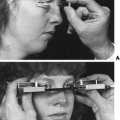LABORATORY DIAGNOSIS
Part of “CHAPTER 45 – HYPOTHYROIDISM“
THYROID HORMONE MEASUREMENTS
In patients with typical symptoms and signs, the diagnosis of hypothyroidism generally can be confirmed by measurement of the FT4 level. Hypothyroidism is characterized by a decrease
of T4 secretion and a decrease of the serum FT4 levels; measurement of total T4 levels in serum usually correlate with levels of FT4. However, alterations of plasma thyroid hormone– binding proteins can result in decreased serum total T4 values in the absence of hypothyroidism or in normal total T4 values in the presence of hypothyroidism. A decrease in serum-binding proteins and serum total T4 levels occurs most commonly in chronic nonthyroidal illness, but it also occurs during androgen treatment and in patients with a hereditary decrease in serum T4–binding globulin. Alternatively, an increase in serum T4–binding may occur because of estrogen-containing medications, pregnancy, acute liver dysfunction, human immunodeficiency virus infection, or several familial syndromes. Because thyroid regulation is not affected by abnormalities of thyroid hormone binding, the levels of serum FT4 and TSH are in the normal ranges. In nonthyroidal disease, serum FT4 may be in the normal range or increased. This contrasts with the findings in a patient with hypothyroidism in whom the serum FT4 is decreased.28 Thus, the measurement of serum FT4 may be helpful.
of T4 secretion and a decrease of the serum FT4 levels; measurement of total T4 levels in serum usually correlate with levels of FT4. However, alterations of plasma thyroid hormone– binding proteins can result in decreased serum total T4 values in the absence of hypothyroidism or in normal total T4 values in the presence of hypothyroidism. A decrease in serum-binding proteins and serum total T4 levels occurs most commonly in chronic nonthyroidal illness, but it also occurs during androgen treatment and in patients with a hereditary decrease in serum T4–binding globulin. Alternatively, an increase in serum T4–binding may occur because of estrogen-containing medications, pregnancy, acute liver dysfunction, human immunodeficiency virus infection, or several familial syndromes. Because thyroid regulation is not affected by abnormalities of thyroid hormone binding, the levels of serum FT4 and TSH are in the normal ranges. In nonthyroidal disease, serum FT4 may be in the normal range or increased. This contrasts with the findings in a patient with hypothyroidism in whom the serum FT4 is decreased.28 Thus, the measurement of serum FT4 may be helpful.
Although triiodothyronine (T3) is the most biologically active of the thyroid hormones, a decrease in serum T3 concentration is not a sufficiently specific marker of hypothyroidism to be useful diagnostically. As with T4, the serum T3 value may be affected by alterations in serum iodothyronine–binding proteins; it also may be low in elderly patients. Nonetheless, in the absence of significant nonthyroidal disease, FT4 levels are normal in patients as old as 110 years of age.29 Serum T3 levels frequently are decreased in euthyroid patients with nonthyroidal disease and during fasting or food restriction because of a diminished extrathyroidal conversion of T4 to T3. Because of the common occurrence of low serum T3 values in euthyroid patients, serum levels of this hormone should not be used to confirm hypothyroidism.30
Stay updated, free articles. Join our Telegram channel

Full access? Get Clinical Tree






